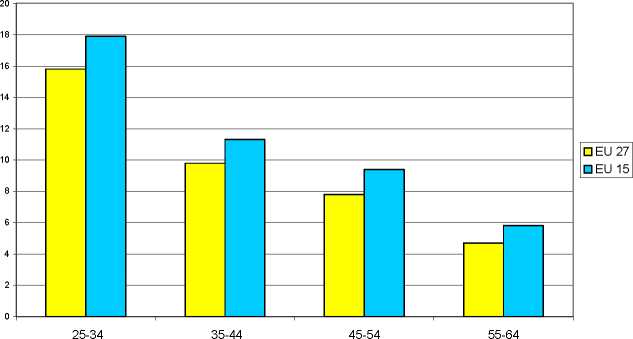Job quality and labour market performance | 11
|
NMS 10 |
15-24 |
11,5 |
22,2 |
6,4 |
41,9 |
13,5 |
23 |
|
NMS 10 |
25-49 |
11,7 |
21,4 |
6,3 |
14,4 |
5,1_____________ |
35,7 |
|
NMS 10 |
50-64 |
12,8 |
21,1 |
5,1 |
10,1 |
9,5____________ |
16,9 |
|
NMS 10 |
15-64 |
11,9 |
21,4 |
6 |
16,2 |
6,9____________ |
27,6 |
Source: LFS (2006 for NMS, 2007 for EU15).
We do not present figures on wages by age class as it is quite well known that wages increase
with age. All in all, the indicators presented here show a rather negative picture of the youth
situation in terms of job quality. However, there is one point on which young people are in a
somehow better position than other workers: namely the participation in further training. The
proportion of people undergoing training periods in Europe differs slightly between EU15 and
New Member States but everywhere we witness a bias in favour of younger workers. Training
rates progressively decrease with age from 15.8% participation for people between 25 and 34
years old to 4.7% for people aged between 55 and 64 years old.
hal-00616771, version 1 - 24 Aug 2011
Table 4. Access to further training by age (% of the adult population)
|
Training |
25-34 |
35-44 |
45-54 |
55-64 |
|
EU 27 |
15,8 |
9,8___________ |
7,8__________ |
4,7__________ |
|
EU 15 |
17,9 |
11,3 |
9,4___________ |
5,8___________ |
Source: Compendium (2009).
Figure 8. Participation in training and education by age class

Source: Compendium (2009).
4.2 Is job quality gender-biased in the European Union?
One of the four main components of job quality concerns gender equality and conciliation
between working and family life. This dimension is particularly emphasised in the European
definition of job quality if we consider the proportion of Laeken indicators devoted to this
aspect of job quality. It is thus interesting to compare the jobs of men and women in reference to
a certain number of available job quality indicators.
More intriguing information
1. Understanding the (relative) fall and rise of construction wages2. Language discrimination by human newborns and by cotton-top tamarin monkeys
3. The name is absent
4. Outsourcing, Complementary Innovations and Growth
5. The name is absent
6. TOMOGRAPHIC IMAGE RECONSTRUCTION OF FAN-BEAM PROJECTIONS WITH EQUIDISTANT DETECTORS USING PARTIALLY CONNECTED NEURAL NETWORKS
7. Visual Perception of Humanoid Movement
8. The name is absent
9. Manufacturing Earnings and Cycles: New Evidence
10. Fortschritte bei der Exportorientierung von Dienstleistungsunternehmen